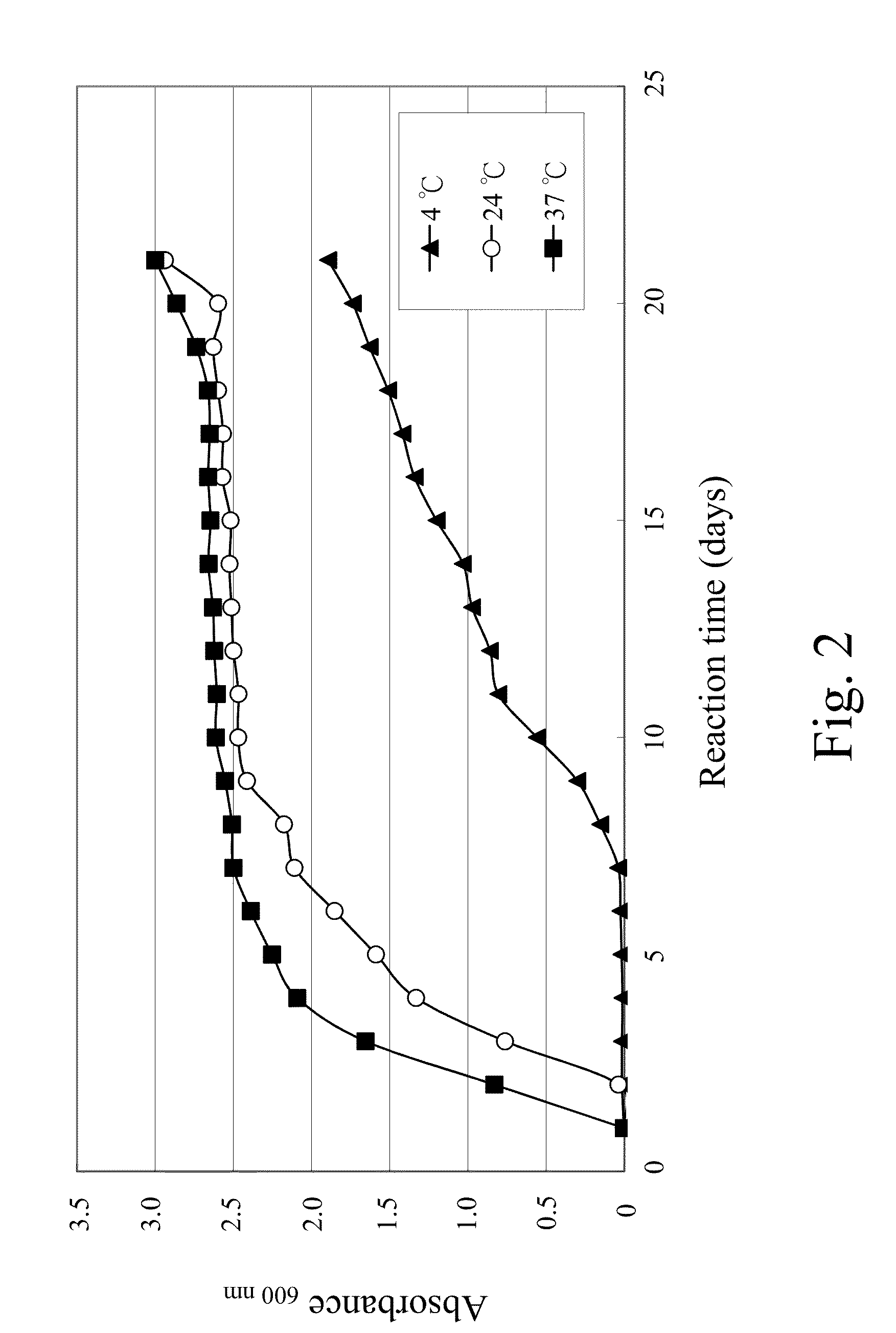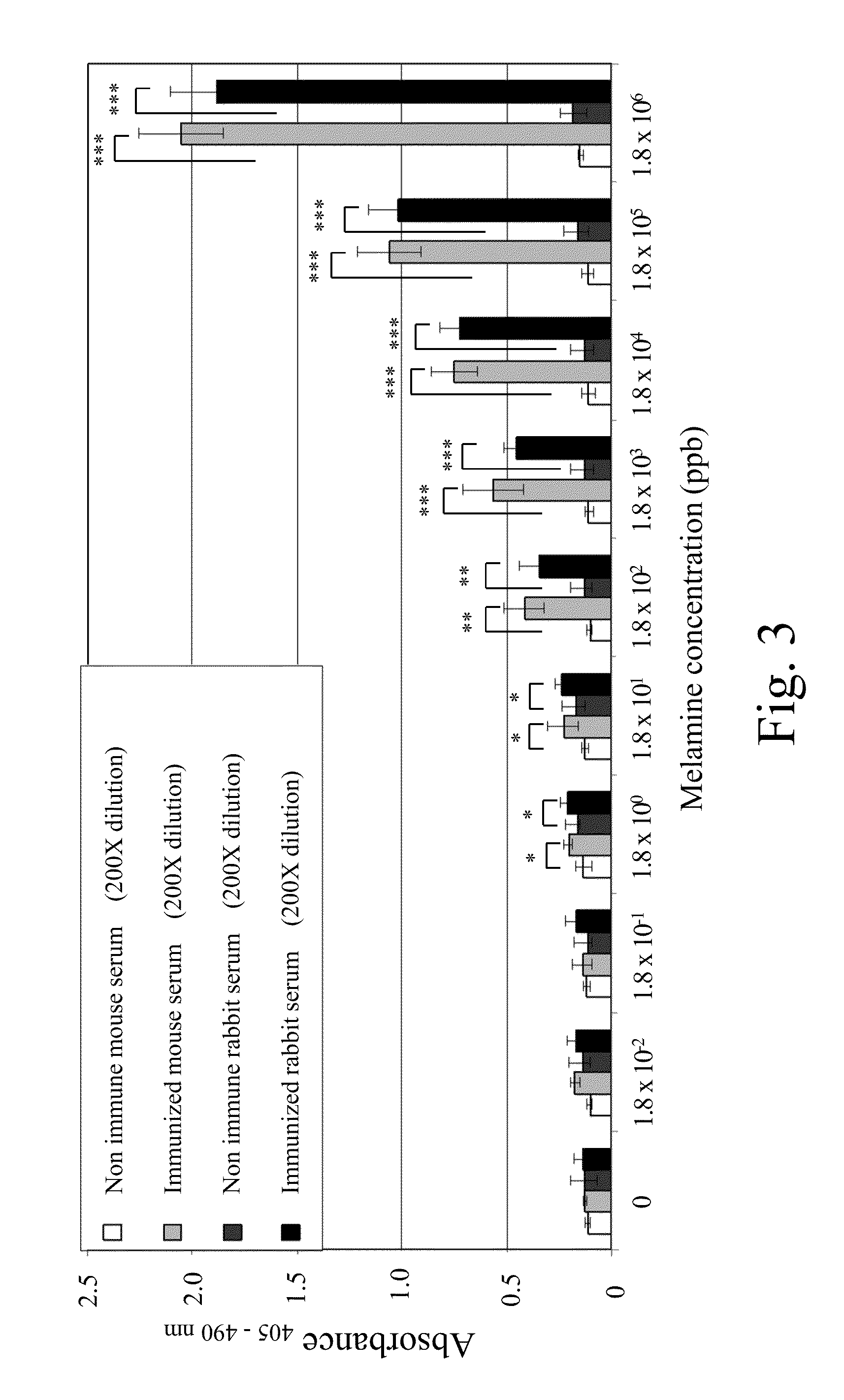Methods for polymering haptens into immunogens
a technology of immunogen and hapten, which is applied in the direction of antibody medical ingredients, carrier-bound antigen/hapten ingredients, pharmaceutical active ingredients, etc., can solve the problems of inability to provoke antibody production in animals by themselves, limited approach, and inability to always be easily available, so as to confirm the effectiveness of the polymerized melamine in stimulating the immune system of animals
- Summary
- Abstract
- Description
- Claims
- Application Information
AI Technical Summary
Benefits of technology
Problems solved by technology
Method used
Image
Examples
embodiment 1
Polymerization Reaction
[0019]Prepared 0.9 mL of 20 mM melamine (2.52 mg in 1 mL H2O) in a glass vial and added to it 0.1 mL of 2.5 M glutaraldehyde, followed by incubation at 37° C. White precipitates, which are polymerization product of melamine, was observable after 3 days, and the polymerization degree of melamine reached to its plateau after 7 days (FIG. 2).
[0020]
[0021]After polymerizing for 3 days at 37° C., 20 μL of the reaction sample was loaded onto a G-10 column and eluted with water at a flow rate of 0.4 mL / min. Fractions of 1 mL were collected and to each of them the UV absorbance at 214 nm was measured. Other than the reaction sample, 20 μL of 18 mM melamine and 20 μL of 250 mM glutaraldehyde, as controls, were also added to and eluted from the G-10 column respectively, using the same conditions as described above. The elution profiles of all three aforementioned samples are shown in FIG. 1, and from which it is estimated that ca. 28% of melamine in the polymerization re...
embodiment 10
Animal Immunization
[0026]To immunize animals (New Zealand White rabbits and Balb / c mice) with polymerized melamines, the reaction sample prepared from Embodiment 1 was used. Depending on the species of animal to be inoculated, various amounts (mouse: 0.143 mL / each inoculation; rabbit: 0.43 mL / each inoculation) of the reaction sample were added to microfuge vials respectively, washed with ddH2O for three times, and each of the final precipitates was re-suspended with ddH2O to a final volume of 0.5 mL and used as the immunogen. For the first immunization, the 0.5-mL immunogen was emulsified with 0.5 mL of complete Freund's Adjuvant and then administered intraperitoneally and subcutaneously to each mouse or intramuscularly and subcutaneously to each rabbit. Four weeks later, a second immunization was performed as the first immunization, except the incomplete Freund's Adjuvant, instead of the complete Freund's Adjuvant, was used. The final booster was given two weeks after the second im...
PUM
| Property | Measurement | Unit |
|---|---|---|
| molecular weight | aaaaa | aaaaa |
| temperature | aaaaa | aaaaa |
| molecular weight | aaaaa | aaaaa |
Abstract
Description
Claims
Application Information
 Login to View More
Login to View More - R&D
- Intellectual Property
- Life Sciences
- Materials
- Tech Scout
- Unparalleled Data Quality
- Higher Quality Content
- 60% Fewer Hallucinations
Browse by: Latest US Patents, China's latest patents, Technical Efficacy Thesaurus, Application Domain, Technology Topic, Popular Technical Reports.
© 2025 PatSnap. All rights reserved.Legal|Privacy policy|Modern Slavery Act Transparency Statement|Sitemap|About US| Contact US: help@patsnap.com



